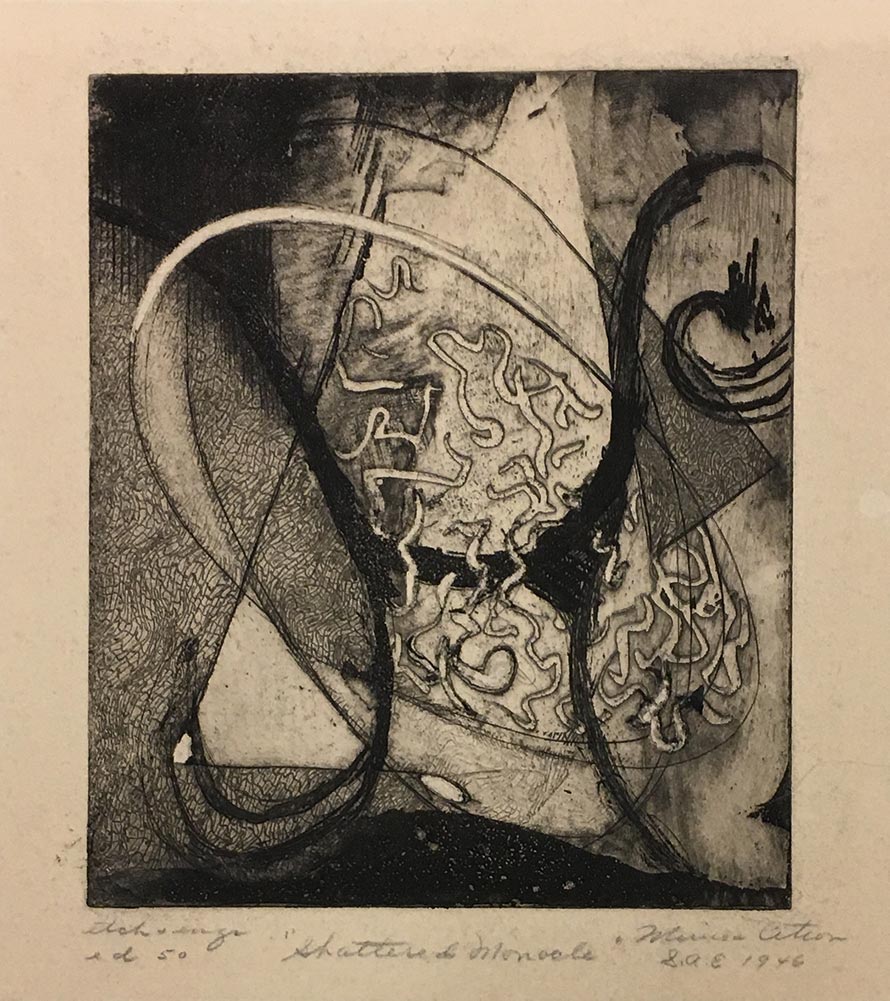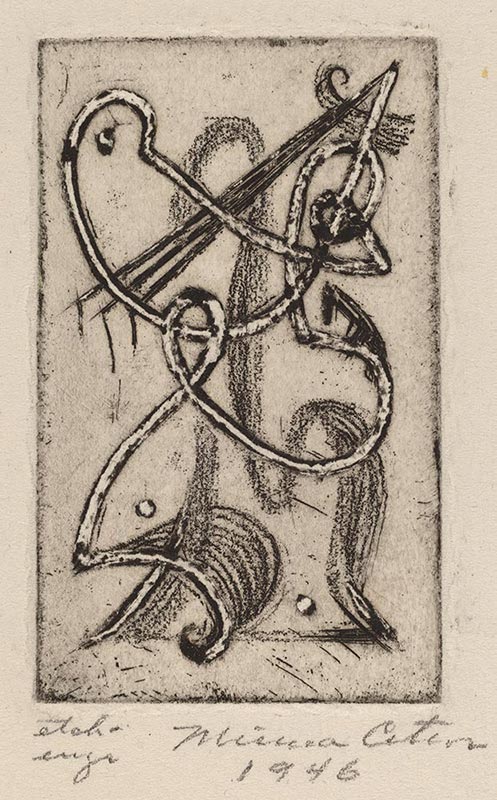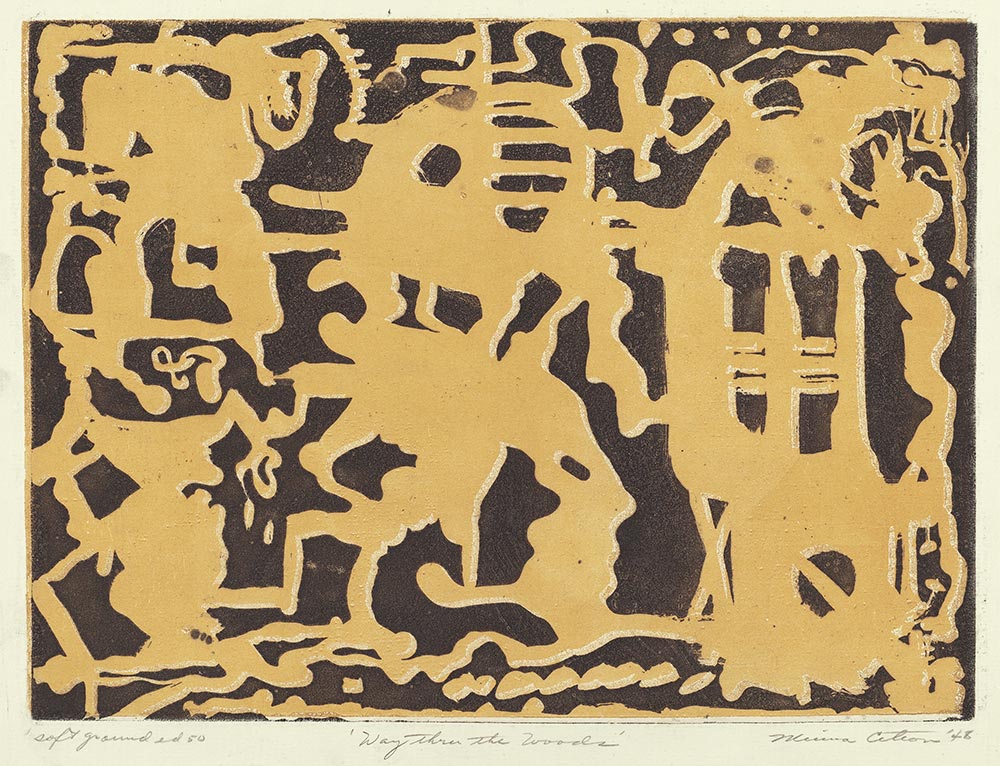18. Minna Citron
| Life Dates | 1896-1991 |
| Place of Birth | Newark, NJ, USA |
| Place of Death | New York, NY, USA |
| Birth Name | Minna Wright |
Born in New Jersey but raised in Brooklyn, Minna Wright was the much-desired daughter and fifth child of well-established merchants.1 She married in 1917 at the age of twenty to Henry Citron, following a courtship of getting to know one another through their common interests in dancing and sports like tennis, golf, and horseback riding.2 Her overbearing mother, having been widowed in 1905 when Minna was just eight years old, wholeheartedly approved the marriage, encouraging her daughter to follow societal norms that “girls must marry.”3
Although Minna Citron did not recognize her ambitions to be an artist until around 1924, she realized almost immediately that she desired more independence to pursue interests outside of her marriage. When the United States entered World War I only two weeks after their marriage, she joined the American Red Cross Motor Corps. Her husband objected to this volunteer activity, presumably because it distracted from the expectation of her full-time duties as a wife, and balked at the idea of her driving the ambulance (they compromised and she instead rode inside as a nurse). Because of her husband’s prosperity working for his family’s paper box manufacturing business, Citron had a fair amount of help caring for the couple’s two sons—born in 1919 and 1923—but she was unhappy in her life and marriage (compounding things, her domineering mother had moved in with the young couple).4 She watched as her friends had “their two babies” and “eas[ed] their way out of the house and into professions.”5 One friend, in particular, enrolled in the psychology program at the New York Social Work School, and Citron tagged along to a lecture by Marion Kenworthy (1891-1980). Sigmund Freud’s ideas were already in the air, and this and other experiences reinforced a growing consciousness of her personal growth as an individual from the “immature girl” her husband had married.6 On the advice of a psychologist at her children’s school, she entered psychoanalysis with Frankwood E. Williams (1883-1936) around the middle of the decade. Citron recalled in later autobiographical writings that she hoped the lengthy process of analysis would allow her to “achieve more personal freedom” and “grow up.”7
She began to test new waters by attending art classes at the Brooklyn Institute of Arts and Sciences (1924-25), the New York School of Applied Design for Women (1925-27), and the Art Students League starting in summer 1928. She pursued classes with Kenneth Hayes Miller and Kimon Nicolaïdes, among others. Flexing her independence outside the home, she also regularly attended Miller’s Wednesday night tea party at his studio and remembered “I’m free!” when taking the bus back to her apartment.8
Shortly thereafter, Citron embarked on two European trips, first in June 1931, taking her older son Casper to Paris with a group of classmates from the Art Students League, and the following summer she went to Germany with her younger son.0
Citron’s professional breakthrough was her “Feminanities” show at Midtown Gallery in May 1935 (the title intentionally elided the words “femininity” and “inane” to form a pun suggesting Citron’s views about the depleted state of women’s civic engagement).9 Previously, she had two solo shows in 1932—one of paintings at Brownell-Lambertson Gallery in February and the other of drawings and lithographs at the New School in November—and neither generated much critical notice. This third exhibition at Midtown caused such a stir that every local paper carried a review and even the national Time magazine offered a short feature.10 Citron’s paintings called attention to the superficiality and immaturity of middle-class American women by parodying aspects of their daily life, like shopping and beauty culture. In the post-suffrage decades, collective feminist action had waned as several disparate ideological factions competed to effect measurable change for women’s position in American politics and society. Within six months of the Midtown exhibition, Citron would move to dissolve her divorce—her first petition in New York state, where she alleged adultery in what seemed to be trumped up charges, was unsuccessful, and she instead went to Nevada for a “Reno divorce.”11 Her point of view in the interviews she gave reporters about “Feminanities” was of a liberated woman urging other women to take charge of their lives and become fully realized individuals. In one newspaper, Citron is quoted as saying “Women are such children: I want to see them adult.”12
Minna Citron’s initiation to Atelier 17 was significant to her career, as she switched from realism to abstraction. After the success of “Feminanities,” Citron became most associated with the Fourteenth Street School, a loose affiliation of painters—most notably Kenneth Hayes Miller, Reginald Marsh, Raphael Soyer, Moses Soyer, and Isabel Bishop—who worked in and around Union Square and depicted the neighborhood’s primary activities: shopping and lunching, mostly done by female consumers and store clerks.13 Marsh and Bishop were some of Hayter’s earliest pupils at the New School, and it is likely through these colleagues that Citron learned of Atelier 17.14 While Hayter’s teachings about automatism and unearthing unconscious imagery through engraving did not alter either Marsh’s or Bishop’s characteristic urban realist style, Citron was ready for a change. In January 1946, Citron held a solo show at ACA Gallery, which consisted of her first experiments in abstraction.15 New York Times critic Edward Alden Jewell joked about what he perceived to be her sharp detour from realism: “her hegira into abstraction has been … headlong. In fact, she has become full-fledged over night… . Citron, in her present flux, seems most convincing when she just lets go and the hell with nature.”16 Similarly, Kenneth Hayes Miller, her friend, mentor, and teacher, warned her not to pursue this stylistic experiment. In an interview she recalls their exchange:
Miller warned me, ‘Minna, if your work changes, you’ll lose your following.’ Well, I said, ‘Well, I’m gonna do what I wanna do.’ And I think that’s been the thing that has made me very happy in life. If you’re not free to do what you feel you should be doing, it’s just as though you were handcuffed or chained. If somebody or something is holding you back, maybe you have to pay a price to break the connection, but why not pay if its something that’s important to you?17
Beginning her affiliation with Atelier 17 in 1946 at fifty not only solidified Citron’s stylistic departure into what she saw as a freer expression, it also brought her in contact with a new network of like-minded modernists. Her Atelier 17 colleagues—particularly her lifelong friend and collaborator Jan Gelb—were not disparaging of her shift, but instead encouraging of her search for self-actualization and supported her exploration into her inner psyche. The prints Citron made after 1946 are mostly abstract but with playful, witty titles that often confused (male) critics who interpreted the works as unserious and lighthearted—but they were anything but that.
Archives
Minna Wright Citron Papers, 1930–1980, Archives of American Art, Smithsonian Institution, Washington, D.C.
Selected Bibliography
Brodsky, Judith, ed. Minna Citron at 90: Women Artists Series at the Mabel Smith Douglass Library, Douglass College. New Brunswick, NJ: Rutgers, the State University of New Jersey, 1986.
Citron, Minna. “Changing Attitudes Toward Art,” 1949. reel 268, grid 885, Minna Wright Citron Papers, Archives of American Art, Smithsonian Institution.
———. “Credo.” Iconograph, Fall 1946, 6.
———. “The Uncharted Course.” Impression, no. 4 (Fall 1958): 23–25.
Kotre, John N., and Elizabeth Hall. Seasons of Life: Our Dramatic Journey from Birth to Death. Boston: Little, Brown, 1990.
Kup, Karl. The Graphic Work of Minna Citron, 1945-1950. New York: New School for Social Research, 1950.
Maloney-Rose, Mary. “Atelier 17 As Catalyst: Minna Citron And Sue Fuller, 1930-1970.” M.A. thesis, Michigan State University, 1981.
Minna Citron: A Survey of Paintings and Works on Paper, 1931-1989. New York: Susan Teller Gallery, 1990.
Resseguier, Clemens. “Minna Citron: Her Work and Her Stories,” circa 1980. Judith Brodsky Papers, Rutgers University Special Collections.
Streb, Jennifer L. “Minna Citron: A Socio-Historical Study of an Artist’s Feminist Social Realism in the 1930s.” PhD diss., The Pennsylvania State University, 2004.
———. Minna Citron: The Uncharted Course from Realism to Abstraction. Huntington, PA: Juniata College Museum of Art, 2012.
———. “Minna Citron’s ‘Feminanities’: Her Commentary on the Culture of Vanity.” Woman’s Art Journal 33 (Spring/Summer 2012): 17–24.
Notes
- It should be noted that Citron’s Jewish surname was Anglicized from Recht to Wright after her father’s family, from the region of Alsace in France, came to America. ↩
- Clemens Resseguier, “Minna Citron: Her Work and Her Stories” circa 1980, 20, Judith Brodsky Papers, Rutgers University Special Collections, New Brunswick, NJ. Minna Citron was not good at remembering dates (particularly about her marriage), and she often stated her wedding occurred in 1916. However, she and Henry Citron obtained their marriage license in 1917. See “Marriage Licenses,” Brooklyn Daily Eagle, March 15, 1917, 12. ↩
- Clemens Resseguier, “Minna Citron: Her Work and Her Stories” (circa 1980), 20, Judith Brodsky Papers, Rutgers University Special Collections. ↩
- The Citron family’s box manufacturing company—Shampain, Citron and Clark—was based in Elizabeth, New Jersey and made luxury gift boxes for major department stores. ↩
- As quoted in Resseguier, “Minna Citron,” 26. ↩
- As quoted in Resseguier, 30. ↩
- As quoted in Resseguier, 33. ↩
- As quoted in John N. Kotre and Elizabeth Hall, Seasons of Life: Our Dramatic Journey from Birth to Death (Boston: Little, Brown, 1990), 340. ↩
- For more on this show, see chapter 2 in Jennifer L. Streb, “Minna Citron: A Socio-Historical Study of an Artist’s Feminist Social Realism in the 1930s” (PhD diss., The Pennsylvania State University, 2004). ↩
- “Feminanities,” Time, May 6, 1935, 34. ↩
- Similar to her inaccurate memory of her wedding date, Citron’s often stated her divorce happened in 1934 but it was 1936. Local New York newspapers ran gossipy stories about the Citrons’s divorce trial in January 1936. It appears Minna Citron hired a private detective to catch Henry committing adultery, but he pleaded it was a set up and the jury agreed. See “Framed, Citron Cries in His Story to Jury,” Brooklyn Daily Eagle, January 9, 1936, 1, 2; “Round’n Around’n Around – and It Comes Out – in Court,” New York Post, January 9, 1936, 3. The Reno Gazette-Journal recorded the divorce decree on May 20, 1936. ↩
- As quoted in Geraldine Sartain, “Woman Artist Tries to Ridicule Feminine Silliness With Brush,” New York World-Telegram, April 19, 1935. ↩
- For an excellent study on the Fourteenth Street School, see Ellen Wiley Todd, The “New Woman” Revised: Painting and Gender Politics on Fourteenth Street (Berkeley: University of California Press, 1993). ↩
- Marsh had been practicing engraving since the 1930s, having learned from retired bank note engraver. He was in the first class of students enrolled in Hayter’s class in the fall of 1940. See Norman Sasowsky, The Prints of Reginald Marsh (New York: C. N. Potter; distributed by Crown Publishers, 1976), 30–31; Gerald W. R. Ward, ed., The Grove Encyclopedia of Materials and Techniques in Art (New York: Oxford University Press, 2008), 198. Bishop studied with Hayter in 1943. See catalogue entries 7A and 12A in Susan Teller and Alan Hyman, Isabel Bishop: Etchings, Engravings and Aquatints: A Catalogue Raisonné, 3rd ed. (San Francisco: Alan Wofsy Fine Art, 2000). ↩
- The catalogue for the show at ACA Gallery can be found in the Minna Wright Citron Papers, Archives of American Art, Smithsonian Institution, reel 97:524-525. ↩
- This clipping is located in the Newark Public Library’s artist file for Citron. It bears the New York Times logo and is hand-dated January 1, 1946, but the author has been unable to confirm exactly when the review ran. In his text, Jewell cites paintings that were in the ACA Gallery show (Hauteur, Continuum, and Devastation). ↩
- As quoted in Kotre and Hall, Seasons of Life, 340–41. ↩



